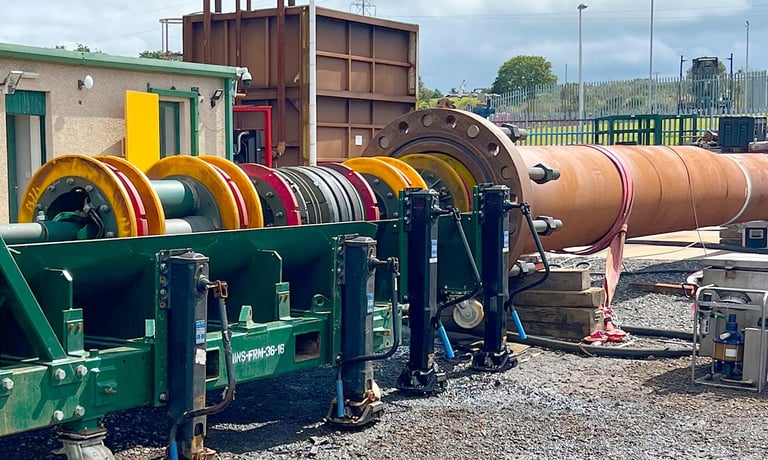
STATS solutions give operators confidence that even the most complex decommissioning tasks can be executed safely and efficiently.
As the North Sea oil and gas basin enters a new chapter, the conversation is increasingly focused on decommissioning - and for good reason. Over the next decade, a wave of aging wells and platforms will reach the end of their operational life, marking a critical turning point for the industry. Decommissioning is not just a technical necessity; it’s an environmental and economic imperative.
This unprecedented phase brings both challenge and opportunity. Operators must balance safety, cost and environmental stewardship while navigating complex regulatory landscapes. The stakes couldn’t be higher: improper or incomplete decommissioning can risk environmental damage, breach legal obligations, and drive-up costs exponentially.
One of the key challenges in decommissioning is managing the safe removal of hydrocarbons from pipelines and topside assets. At the heart of this task is isolation – providing a high integrity barrier to ensure subsea pipelines can be safely flushed and decommissioned without the risk of becoming repressurised, flooded or contaminating subsea environments. Without effective isolation, there’s a real risk of hydrocarbons escaping, posing a hazard to marine environments and undermining the integrity of the entire decommissioning operation.
That’s where STATS Group comes in. Known globally for its expertise in pressurised pipeline isolation, mechanical connections and abandonment plugs, STATS has built a strong reputation for helping operators carry out decommissioning activities to the highest standards of safety and environmental compliance.
"This is a critical and challenging time for decommissioning in the UK Continental Shelf (UKCS), with costs continuing to rise. As a result, operators are actively seeking technologies and solutions that enable safe, efficient, and cost-effective execution of decommissioning activities. STATS’ range of isolation plugs and mechanical connectors provide robust, proven solutions to help operators meet their regulatory and operational obligations." said Andy Norrie, STATS Group Head of Sales and Business Development, Europe. Central to STATS’ offering is its DNV type-approved Tecno Plug® - a proven technology delivering fail-safe, double block pipeline isolation. This advanced isolation system allows operators to work on pipelines that remain pressurised, creating a zero-energy zone between dual seals. This zone is critical: it ensures both seals are tested and verified leak-tight before any cutting, cleaning, or abandonment work begins. The ability to pressure-test and vent to ambient creates a robust safety barrier, protecting workers, the environment, and the integrity of the pipeline.
These technologies are more than theoretical; they’re already making a tangible difference across the North Sea. In one major project, STATS used remotely operated abandonment plugs and mechanical end caps to safely isolate and terminate 16in and 30in pipelines, enabling decommissioning to proceed efficiently. In another case, a novel application of an isolation plug allowed an 8in pipeline to be cut and permanently abandoned, all without the need for expensive subsea work vessels. This alone represented a significant cost saving and reduced environmental risk, demonstrating how smarter technology can transform the economics of decommissioning.
 16in Subsea End Cap Connector, Pipeline Abandonment (154 bar design pressure)
16in Subsea End Cap Connector, Pipeline Abandonment (154 bar design pressure)
One of the most striking examples of STATS’ capabilities involved the decommissioning of a 90 bar gas pipeline in the Dutch North Sea. By deploying a 24in isolation plug from the platform, 32 kilometres along the line, STATS enabled the safe cleaning, disconnection, and permanent abandonment of the pipeline, a feat that would have been vastly more complex and expensive with conventional methods.
What sets STATS apart isn’t just its technology but its unwavering commitment to safety and environmental responsibility. Its Tecno Plug technology is fully certified to the highest industry standards, including DNV-OS-F101 for Submarine Pipeline Systems and DNV-RP-F113 for Subsea Pipeline Repair. Combined with engineering expertise to address corrosion, ovality, and aging infrastructure, STATS solutions give operators confidence that even the most complex decommissioning tasks can be executed safely and efficiently.
In addition to isolation plugs, STATS SureConnect® subsea mechanical pipe connectors are increasingly in demand to provide a safe, weld-free solution for the decommissioning of offshore platforms and pipeline infrastructure. Engineered for tie-ins, repairs, and end-capping of pipelines and risers, the slipover design and mechanical locking assembly create a robust flanged connection, eliminating the need for hyperbaric welding and reducing operational risk and complexity.
 30in Subsea End Cap Connector, Pipeline Abandonment (175 bar design pressure)
30in Subsea End Cap Connector, Pipeline Abandonment (175 bar design pressure)
SureConnect features dual independently activated seals and taper locks to ensure secure installation and reliable seal testing in challenging subsea environments. As decommissioning activity accelerates, particularly in regions like the North Sea, demand for rapid and flexible mechanical connector solutions is rising.
Andy Norrie commented, “We are experiencing a great deal of interest in our SureConnect range, its versatility, whether for flanged outlets, plain-end couplings, or pipe end caps, combined with compliance to industry standards, makes it ideal for pipeline abandonment and decommissioning.”
Proven in global applications, SureConnect supports not only traditional decommissioning but also the repurposing of infrastructure for hydrogen and Carbon Capture, Usage and Storage (CCUS) projects, aligning with energy transition goals.
As the North Sea’s energy landscape evolves, it’s clear that decommissioning will define the next era. By investing in proven, innovative solutions like those offered by STATS, operators can meet their legal, environmental, and financial obligations head-on, and set a new standard for responsible resource management.